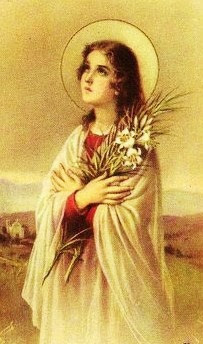 |
| The original outdoor altar where the first Mass was celebrated on our property. |
 |
| This is the shrine today, with the original wooden altar encased in stone. |
The annual celebration of the Solemnity of Corpus Christi, with the procession from the high altar to the outdoor shrine for Benediction of the Blessed Sacrament, serves also as a reminder of our roots because this shrine marks an important place on our church grounds. It's the site of “the finding of the crucifix,” and also the place where the first Mass was celebrated on the property. Here's the story.
After the parish was canonically erected on 15th August 1983, I began to search for a permanent location for us to worship and to grow from our original eighteen people. We were, at that time, meeting at San Francesco di Paola Church, in downtown San Antonio. It was a lovely little place, built by Italian immigrants, but the location was ill-suited for us. Everyone had to travel quite a distance, and it was difficult to build up a communal life in a place which was fairly remote for all of us. So I began to look for some land.
It seemed to me that the future growth of San Antonio would be taking place on the northwest side of the city. Everything pointed to it, and that has indeed come to pass. The archdiocese had (several years before) purchased a small plot of land for the possibility that a territorial parish might be needed. When I inquired about locating our parish there, the answer was, “Yes, that would be fine. There’s not much happening out there anyway, and we probably won’t need it for a territorial parish.” The short-sightedness of that statement aside, it worked out well for us. To get the property, we were required to pay a rather hefty sum to the archdiocese, which eventually we did.
I knew this was the spot. I had visited it before making the request. I had to crawl through the underbrush, literally on my belly, to make any kind of exploration. I had a small medal of Our Lady of the Atonement with me, and I buried it in the earth as I was making my slow process through the woods and brush, claiming it for our Lady and her parish. Shortly after burying the medal, I came into a small clearing, allowing me to stand up. With the thick undergrowth surrounding me, I saw in the middle of the clearing a wooden cross stuck into the ground, and fastened to the rough cross was a small crucifix. I took it as a sign. This was the place. This was where our Lord and His Blessed Mother wanted us to be. But I need to tell you why such a sign was necessary.
At the same time as I had requested the possibility of our getting the land, some Dominican priests had approached the archbishop about staffing a chaplaincy for the University of Texas, which is a short distance away. Even though we had asked first, the archbishop thought perhaps a better use for the land would be to give it to the Dominicans. I told the archbishop, “You can’t! I’ve already claimed it for Our Lady of the Atonement.” He expressed his regret, but told me his mind was set. I warned him that we’d begin praying. And so we did.
For nine evenings we gathered to pray the Novena to the Holy Ghost. By the fourth evening, the archbishop contacted me. “I don’t know what kind of prayer you’ve been saying,” he said, “but the situation with the Dominicans has fallen through. You can build there.” We finished the novena as an act of thanksgiving. We were intensely grateful to God, but not surprised at what He had done. Certainly, I have nothing against the Dominicans, but the Blessed Mother had other plans for the land.
I saved that little crucifix. We built a simple wooden shrine to Our Lady of the Atonement on the property where the crucifix had been found, and fastened it onto the peak of the shrine’s roof. In time we made plans to celebrate a Mass there, and to break ground for the church.
Today there stands the completed shrine, a copy of the original wooden one, but now in stone. Within the altar is the simple wood altar which stood there originally, now protected by a permanent stone altar. And the little crucifix is there. It’s mounted in the placed where the tabernacle would normally be, if this were an indoor altar.
So it reminds us of our beginnings, and of how God guided and protected us as new converts to the Catholic faith. There are plaques on either side of the shrine, briefly telling the story, so our children and their children won’t forget that the Lord and His Mother heard our prayers. And every year our Lord Jesus Christ blesses us on this spot through Benediction of His Most Precious Body and Blood.


















